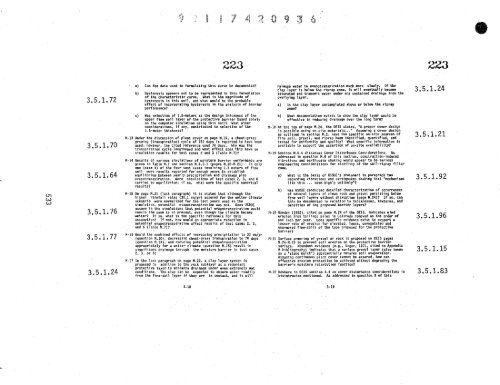EIS-0113_Section_11 - Hanford Site
EIS-0113_Section_11 - Hanford Site
EIS-0113_Section_11 - Hanford Site
Create successful ePaper yourself
Turn your PDF publications into a flip-book with our unique Google optimized e-Paper software.
z<br />
0223 223<br />
3.5.1.72<br />
a) Can the data used in formulating this curve be documented?<br />
b) Hysteresis appears not to be represented in this formulation<br />
of the characteristic curve. What is the magnitude of<br />
hysteresis in this sail, and what would be the probable<br />
effect of incorporating hysteresis in the analysis of barrier<br />
performance?<br />
release water to evapotranspiration much more slowly. If the<br />
clay layer is below the riprap zone, it will eventually become<br />
saturated and transmit water under any sustained drainage from the<br />
overlying layer<br />
a) is the clay layer contemplated above or below the riprap<br />
zone?<br />
3.5.1.24<br />
(l^<br />
W<br />
W<br />
3.5.1.70<br />
3.5.1.64<br />
3.5.1.76<br />
3.5.1.77<br />
3.5.1.24<br />
c) Nos selection of 4.5-metersas' the design thickness of the<br />
u pper fine soil layer of the protective barrier based solely<br />
on the computer simulation using this soil? 'What other<br />
considerations, if any, contributed to selection of the<br />
1.5-meter thickness?<br />
M-13 Under the discussion of plant cover on page M.19, a cheat-grass<br />
growing (transpiration) cycle of 152 days is reported to have been<br />
used; however, the cited reference used 70 days; Why was the<br />
transpiration cycle lengthened and what effect does this have on<br />
simulation results for test cases 7 and 3 (Table M.7)?<br />
M-14 Results of various simulations of moisture barrier performance are<br />
given in Table M.7 and section M.5.2.1 (pages M.20-M.21). In only<br />
ane (case 4) of the four test cases involving 1.5 meters of fine<br />
soil were results reported for enough years to establish<br />
equilibrium between yearly precipitation and drainage plus<br />
evapotranspiration. Were simulations of lest cases 2, 3, and 6<br />
carried to equilibrium; if so, what were the specific numerical<br />
results?<br />
M-15 On page M.21 (last paragraph) it is stated that although the<br />
higher rainfall rates .(30.1 cm7yr) assumed for the wetter climate<br />
scenario were normalized for the test years used in the<br />
simulation, potential evapotranspiration was not. Does USDOE<br />
assume in the simulations that potential evapotranspiration would<br />
remain the same as at present, even though the climate became<br />
wetter? If so, what is the specific rationale for this<br />
assumption? If not, haw would an appropriate reduction in<br />
Potential evapotranspiration affect results of test cases 2, 3,<br />
Table M.7)?<br />
- and 6 (<br />
M- 1 6 Would the combined effects of increasing precipitation to 32 cm/yr<br />
.(question <strong>11</strong>.10), decreasing cheat-grass transpiration to 70 days<br />
(question <strong>11</strong>.13), and reducing potential evapotranspiration<br />
appropriately for a wetter climate (question M.15) result in<br />
significant drainage thr q uen the moisture barrier in test cases<br />
2, 3, or 67<br />
M-17 In the last paragraph onpage M.22, a clay layer system is<br />
proposed to addition to the rock sublayer as a redundant<br />
protective layer to minimize drainage under even extremely wet<br />
conditions. The clay can be expected to absorb water readily<br />
from the fine-soil layer if they are in contact, and it will<br />
b) What documentation exists to show the clay layer could be<br />
effective in reducing drainage ever the long torm?<br />
M-I8 Atthe top of page M,24, the D<strong>EIS</strong> states, 'A proper cover design<br />
is passible as f ng on-site materials...' Assuming a cover design<br />
as outlined. in section M.2, have the specific on-site sources If<br />
fine soil, gravel, and riprap been identified, quantified, and<br />
tested for uniformity and quality? What specific information is<br />
available to support the assertion of on-site availability?<br />
M-19 <strong>Section</strong> M.5.4 discusses Cover Disturbance Considerations. As<br />
addressed in question M.6 of this section, construction-induced<br />
vibrations and earthquake shaking wou d . appear to bbe serious<br />
eng ineering considerations far stability of the sail-riprap filter<br />
zone.<br />
a) What is the basis of USDOE's statement in paragraph two<br />
regarding vibrations and earthquakes shaking that "mechanisms<br />
like this ... seem highly unlikely'?<br />
b) Has USWE conducted detailed characterization of occurrences<br />
of natural layers of clean rock and gravel persistin g . below<br />
fine soil layers Without disruption (page M.24)? If so, can<br />
this he documented in relation to thicknesses, textures, and<br />
'.densities of the proposed barrier layers?<br />
M-20 Bander (1982), cited on page M.24 bf the D<strong>EIS</strong>, indicates wind<br />
erosion from tailings piles in Colorado removed on the order of<br />
one inch per year. Does specific evidence exist to support a<br />
lesser rate of erosion for elevated, loose, upeagetated and<br />
Unarmored fine-soils of the type proposed for the protective<br />
barrier?<br />
M-21 Surface armoring of gravel or rack is proposed on D<strong>EIS</strong> pages<br />
M.24-M.25 to prevent sail 'erosion an the protective barrier<br />
surface. Abundant evidence (e.g., Unger, 1971, cited in Appendix<br />
M bibliography) indicates that a surface gravel layer (also known<br />
as a 'stone mulch") substantially retards sail evaporation.<br />
Assuming continuous plant cover cannot be assured, how can<br />
effective erasion protection be achieved without degrading the<br />
barrier's moisture retardation function?<br />
M-22 Nowhere in D<strong>EIS</strong> section 5.4 on cover disturbance considerations is<br />
biointrusion mentioned. As addressed in question 9 of this<br />
3.5.1.21<br />
3.5.1.92<br />
3.5.1.96<br />
3 .5.1.15<br />
3.5.1.83<br />
348<br />
3.19

















